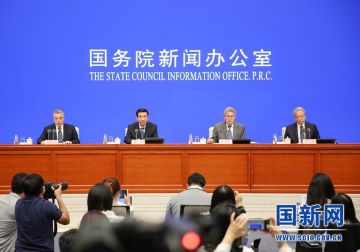Major indicators of China’s industrial operation pick up in April
By Han Xin, People’s Daily
Chinese Minister of Industry and Information Technology Miao Wei(second from left) and other officials answer questions during a press conference held by the State Council Information Office, May 20. Photo courtesy of the State Council Information Office
As of May 18, 99.1% of Chinese industrial enterprises above the designated size had resumed work, and 95.4% of employees from those companies had returned to their posts, Chinese Minister of Industry and Information Technology Miao Wei said on May 20 during a press conference held by the State Council Information Office.
Both the work resumption rate of enterprises and the ratio of employees returning to work have recovered to those in pre-epidemic period thanks to the coordination efforts made by the country.
The added value of enterprises above designated size turned from negative growth to increasing 3.9 percent in April, which was “a very positive sign,” said Miao. Major indicators showed positive changes since March as China’s epidemic prevention and control continues to achieve progress; work resumption accelerates; and restoration of industrial production picks up.
Most industries recovered growth, while supply remained stable in the raw material industry. High-tech manufacturing bucked the downward trend, and new businesses such as remote education, telecommuting and online shopping accelerated expansion.
The added value of high-tech manufacturing increased by 0.5 percent year on year in the first four months, highlighted by growth rate rebounds to 8.9 percent and 10.5 percent in March and April, respectively. The electronic information industry witnessed rapid recovery, with the output of electronic components increasing by 59.2 percent.
Miao introduced that the Ministry of Industry and Information Technology (MIIT) will actively apply the new generation of information technologies to propel epidemic prevention and control, as well as work resumption, and support the innovation and industrial application of 5G, artificial intelligence and blockchain technologies, so as to usher in a new chapter of the high-quality development of China’s digital economy.
Main industrial indicators picked up in April, but enterprises need to further consolidate the fundamentals sustaining growth, Miao remarked. However, the long-term impacts from the epidemic on China’s industries and economy are controllable and won’t change the development trend of long-term growth prospects. With the introduction and implementation of stronger macro policies, the industrial economy is expected to sustain growth in the second quarter, Miao explained.
Miao said that China has encountered big challenges regarding the stabilization of industrial and supply chains due to the spreading epidemic, but China’s industrial system and complete industrial chain played a major role in safeguarding the general stability of the global industrial chain by establishing matching platforms for major industries and removing obstacles impeding the supply and industrial chains.
About 91 percent of China’s small and medium-sized enterprises (SMEs) had resumed operation as of Monday, May 18,said Huang Libin, an MIIT spokesperson and director general of MIIT’s Performance Inspection and Coordination Bureau.
A package of policies has been issued to help SMEs on both central and local levels.
The country enhanced efforts to cut taxes and fees to lower the burden of enterprises. By reducing and exempting the three social insurance contributions of enterprises in the first half of the year, SMEs are expected to save 600 billion yuan ($84.2 billion).
Besides, the country also strengthened financial support to ensure the operation of enterprises. The People’s Bank of China unleashed liquidity of 1.75 trillion yuan, offered low-cost loans of 2.85 trillion yuan to firms, especially micro, small and medium-sized enterprises as well as individual businesses, and deferred over 1 trillion yuan of principal or interest payments for more than 1.1 million micro, small and medium-sized businesses.
In addition, the country is also optimizing public services to promote innovation of enterprises. For instance, it is helping SMEs to lower cost, expand market and stabilize employment through digital technologies.
The MIIT will strictly implement the favorable policies and measures issued for enterprises, further enhance financial support for SMEs, and normalize fees for SMEs in different parts of the country, so as to deliver tangible benefits to SMEs across the country, Miao said.













